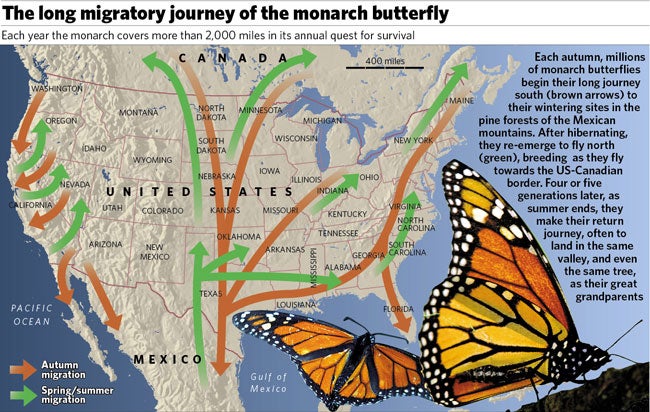How migrating butterflies use body clocks to find their way

The spectacular migration of the monarch butterfly, which covers a 2,000-mile round trip in a year, uses an inbuilt precision clock that enables the insect to use the sun as a compass, a study has found.
An internal biological clock that times the 24-hour cycle of night and day allows the monarch butterfly to calculate its direction of flight when migrating either north or south, depending on the time of the year, scientists have discovered.
Monarch butterflies are famous for the journey they make each spring from their winter roosting sites in the mountain pine trees of Mexico to as far as the US-Canadian border and back again in autumn an unparalleled migratory feat for such as small creature. As the monarchs fly north in spring they breed several times during their summer journey. Four or five generations later, their offspring make the long journey home again, often landing in the same Mexican valley and even on the same tree that their great, great grandparents left the previous winter.
Scientists have known for years that the monarchs use the sun as a compass to guide them on their journey, and as a calendar for telling them when to begin the return journey to Mexico. But a compass based on the sun's moving position in the sky would not work unless the insects also have an accurate clock to tell them the time of day.
No one had been able to locate this internal timepiece, until now. A study by Steven Reppert, professor of neurobiology at the University of Massachusetts Medical School, has identified the key gene in the monarch butterfly that acts as a biological clock for estimating the 24-hour cycle of the circadian rhythm.
Professor Reppert said that the gene was responsible for a light-sensitive protein called cryptochrome (CRY) which counts the passing hours of each day, and also communicates the information to the monarch's inbuilt solar compass for the insect to calculate its correct direction of flight.
It is the second CRY gene to be found in insects. The first, CRY1, was discovered in drosophila fruit flies but the monarch's gene is sufficiently different to warrant a distinctive name, CRY2, Professor Reppert said. "This is a very interesting realignment of how one thinks about insect-clock models. There was no reason to suspect the butterfly clock would be different," he said.
"What we have in the butterfly is an astounding clock mechanism, one that is more similar to our own circadian clock and less similar to the clock of a fly," he said. "We have still to understand how the tiny brain of the monarch butterfly, which is no bigger than the head of a ballpoint pen, can arrange information about time and space that leads it to carry out the appropriate flight behaviour," Professor Reppert told the online journal Public Library of Science.
Subscribe to Independent Premium to bookmark this article
Want to bookmark your favourite articles and stories to read or reference later? Start your Independent Premium subscription today.

Join our commenting forum
Join thought-provoking conversations, follow other Independent readers and see their replies